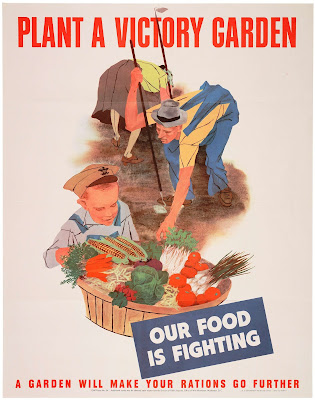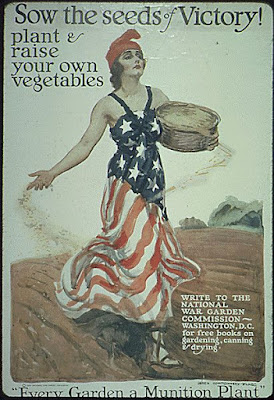
|
|
A Victory Garden poster circa 1943, the height
of the WWII garden popularity. The woman
of the family
is gardening in her stockings! The seam line up the back
of her leg is the giveaway. (Image courtesy
the National Archives)
|
Interest rises in growing food while everyone is sheltering at home
Sacramento is routinely a hotbed of gardening in March, with nurseries packed and long lines of folks buying fertilizer and soil amendment. But even in this gardening-mad region, the effect of the coronavirus shelter-at-home orders seems to be boosting interest in putting in gardens, especial vegetable and herb gardens.
I haven't been out in the world since March 16, and last bought soil amendment on March 11, but like everyone else I spend a lot of time online. And the evidence is there. The nurseries -- deemed essential since they sell supplies for growing food -- are slammed with business.
Social-distancing protocols haven't deterred garden shoppers. The
Plant Foundry
in the Triangle District on Wednesday got a new shipment of tomato and pepper transplants, but has posted a two-per-customer limit. And the plants aren't even out on the tables; customers have to request the varieties they want. (The link is to their Facebook page, which has current updates.)
Green Acres
has put much of its inventory online, and will bring your order to your car and even load it for you in one of their five stores' parking lots.
Fair Oaks Boulevard Nursery
is taking email orders for curbside pickup.
Emigh Hardware
is taking phone orders;
Talini's
in East Sac is, too, during limited hours, and with appointments for pick-ups. And
Big Oak Nursery
in Elk Grove is open; call for information on delivery or pick-up.
Peaceful Valley in Grass Valley long has offered online orders, but with staffing issues is completely shut down, including the website for the time being.
Meanwhile, over on Facebook, many folks, on their own pages or as new followers of the Sacramento Gardening Group, are saying "I want to plant a vegetable garden -- how do I do it?"
My answer: "How much time do you have?" As in, it's an unlimited topic.
But also, how much time do you have, not just this spring, but this summer, this fall? A garden takes time, especially if you're starting with seeds. Carrots take up to 5 months, and don't grow well in clay soul. Lettuce is quicker but often can't handle our late-spring temperatures.

|
|
"Every Garden a Munition Plant" says this
poster
from 1918. (Image courtesy National Archives)
|
Historical perspective is why I note this. The
New York Times
this week has a report on the new interest in growing food all across the country. The story points out that patriotic gardening first became an idea during World War I (see the poster here from 1918), continued during the Spanish flu epidemic, and then got another boost during the Depression and early World War II.
At one point, American home, school and community gardens produced about 40 percent of the nation's fresh fruits and vegetables.
It didn't last, which would be no surprise to any experienced gardener. Here's how the Times story explains it:
But ask any farmer — gardening is hard work, growth is slow and yields can be unpredictable.
In 1943, The
Times
ran a story on the disappointments and failures of the millions of first-time gardeners who had thrown themselves into planting gardens without much experience, and were now hesitant to invest in insecticides or soil tests.
“The First Year Is the Hardest,” the headline assured readers, but it wasn’t assuring enough. A year later, The
Times
reported that “no amount of warning will make people plant their Victory gardens again this year unless they are convinced that they are really needed.”
The craze slowed down. Millions of gardens were abandoned.
I'd hate to see all this new gardening enthusiasm melt away in the first Sacramento heat wave. Growing your own food is satisfying -- I cherish the canned tomatoes and homemade sauce in my pantry now -- but it's work.
If you talk to anyone who's jumping into vegetable gardening for the first time, caution them to take it slow, to research as much as possible, and to understand that even in Sacramento we can't grow everything all at once. Thanks, and good luck to all the newbies.

